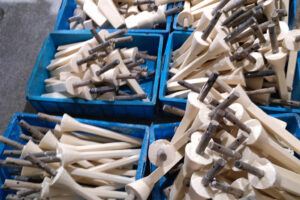Characteristics of Investment Casting
 Investment casting ,also known as lost wax, is very common process for casting parts.As a professional casting manufacturer, we wish to advise the Characteristics of investment casting,their advantage and disvantages. And hope it can help you choose better production method for your new items.
Investment casting ,also known as lost wax, is very common process for casting parts.As a professional casting manufacturer, we wish to advise the Characteristics of investment casting,their advantage and disvantages. And hope it can help you choose better production method for your new items.
The advantages of investment casting process
1.Investment castings exhibit high dimensional accuracy and low surface roughness.
By using precise and smooth soluble patterns, investment casting achieves a monolithic shell without parting lines. This eliminates dimensional errors caused by mold separation, core insertion, and assembly, as commonly observed in sand casting. Investment castings have clear edges and can achieve dimensional accuracy levels ranging from CT4 to CT6, with a surface roughness of Ra0.8 to Ra1.25μm. Hence, investment casting produces components that closely resemble the final shape, reducing the machining workload and conserving metal material consumption.
2. Investment casting is suitable for casting structurally complex and precision-shaped components.
It enables the production of intricate and precise components that are challenging to manufacture using other methods. Examples include various turbines, impellers, hollow blades, directionally solidified blades, single crystal blades, etc. Furthermore, it allows casting of thin-walled components with a thickness as low as 0.5mm, minimum casting holes of 1mm, and mass ranging from 1g to 1000kg. Investment casting can also facilitate the integral casting of previously assembled parts.
3.Investment casting is compatible with a wide range of alloy materials.
It can be applied to produce castings using various alloys, such as carbon steel, alloy steel, stainless steel, high-temperature alloys, copper alloys, aluminum alloys, magnesium alloys, titanium alloys, precious metals, and cast iron. Notably, investment casting is particularly suitable for alloys that are difficult to machine.
4.Investment casting is applicable for both large and small-scale production.
The use of metal molds for investment casting makes it suitable for large-scale production. However, it can also adapt to small-scale or trial production by employing cost-effective gypsum molds, easily meltable alloy molds, or silicone rubber molds (commonly used in art and jewelry casting).
The investment casting process has its limitations:
- The investment casting process is complex, comprising multiple steps. Numerous process factors influence casting quality, necessitating strict control over various raw materials and process operations to achieve stable production.
- Investment casting is most suitable for medium and small-sized castings, capable of casting components with maximum aperture sizes of 3-5mm, maximum through hole sizes of 5-10mm, maximum blind hole sizes of 5mm, minimum casting groove sizes of ≥2.5, and minimum groove depths of ≤5mm.
- The production cycle of investment casting tends to be longer.
- Due to slower cooling rates, investment casting may result in larger grain sizes and surface decarburization layers, especially in carbon steel castings.
Conclusion
The above is basically the common advantages and disadvantages of this process. You can choose the appropriate production process based on the characteristics of your product, so that it can have excellent quality while being cost-effective.






